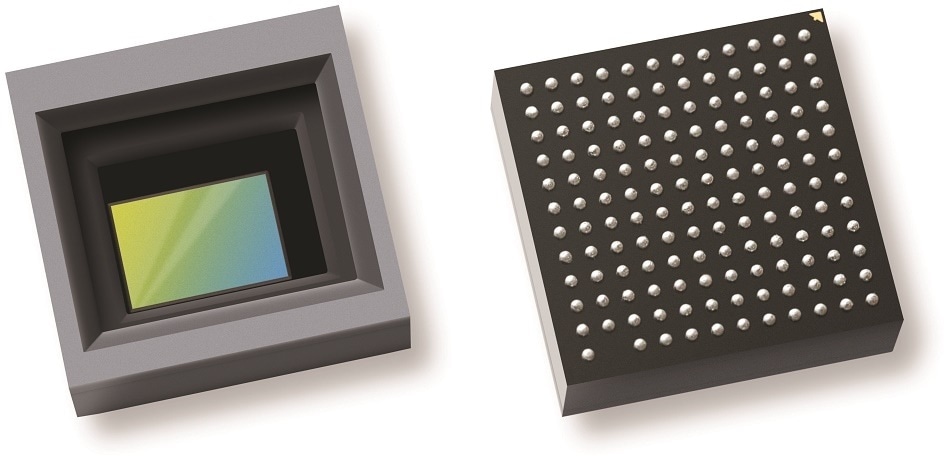OmniVision Technologies, Inc., a leading developer of advanced digital imaging solutions, today announced its high definition (HD) automotive camera module reference design, developed with collaboration from Leopard Imaging and featuring technology from Texas Instruments (TI). The compact design includes OmniVision’s OX01B40 image sensor plus image signal processor (ISP) system-in-package (SiP), as well as TI’s DS90UB933-Q1 or DS90UB935-Q1 serializer chip and TPS65000-Q1 power management integrated circuit (PMIC).
 OmniVision, Texas Instruments and Leopard Imaging collaborated on the automotive industry’s first HD camera module to fit all its components on a single PCB, including the OmniVision OX01B40 image sensor plus image signal processor system-in-package that is shown here.
OmniVision, Texas Instruments and Leopard Imaging collaborated on the automotive industry’s first HD camera module to fit all its components on a single PCB, including the OmniVision OX01B40 image sensor plus image signal processor system-in-package that is shown here.
All four components are AEC-Q100 Grade 2 qualified, with an operating range of -40 to +105 degrees Celsius. The reference design can be integrated directly into vehicles as a low-cost solution with the fastest time to market, or the design can serve as a starter kit for Tier-1s and OEMs who want to create their own camera modules.
The new reference design was created to assist customers in designing automotive viewing cameras, especially rearview cameras or surround-view cameras, where small size, low power consumption, low thermal output, and excellent image quality are critical. This is the first automotive camera module to incorporate all its components on a single printed circuit board (PCB). Existing modules stack at least two PCBs for the image sensor and ISP, respectively, and usually a third for the power ICs.
“As the transition from analog to HD digital cameras in automotive applications moves into the mainstream, our joint reference design meets the need for cameras that are as small and unobtrusive as possible while providing accurate images in all lighting conditions,” said Bill Pu, President at Leopard Imaging. “The compact, low-power components from TI and OmniVision allowed us to achieve our goal of a single-board design.”
OmniVision’s OX01B40 SiP combines a high-performance 1392 x 976-resolution color CMOS image sensor and an ISP. It supports streaming video of up to 60 frames per second (fps) and consumes less than 400 mW of power. Built on OmniVision’s 2.8-micron OmniBSI-2™ Deep Well™ pixel technology, the OX01B40 delivers best-in-class low-light sensitivity and 120 dB high dynamic range (HDR) performance for excellent contrast and for resilience to rapidly changing lighting conditions ranging from darkness to bright sunlight.
“The OX01B40 is perfectly suited for this application,” said Andy Hanvey, director of automotive marketing at OmniVision. “Because of its small size and industry-leading low power consumption, it can enable smaller camera modules with lower thermal output, and its HDR minimizes motion artifacts.”
Handling the power needs in the design, TI’s TPS65000-Q1 single-chip PMIC combines low-dropout regulators with a step-down converter that can operate in forced PWM mode or auto PWM-PFM mode, depending on load, to maximize efficiency. This reference design also offers the choice of either parallel CMOS (DS90UB933-Q1) or MIPI CSI-2 (DS90UB935-Q1) FPD-Link serializers, both of which support communication with high-speed image sensors and are for customers designing high-resolution, compact camera modules with 1-MP cameras streaming at up to 60 fps. The DS90UB935-Q1 also removes the need for an oscillator in the camera module, minimizing cost and space while providing reliability.
“Through this design, automotive engineers can quickly take advantage of the combined knowledge and expertise from OmniVision, Leopard and TI to implement cost-effective, high-performance viewing cameras,” said Hannes Estl, general manager of automotive ADAS at TI. “TI’s power supply and serializer chips enable the high density and small solution size that help realize this very compact 1-MP camera module design.”
The reference design is available now from Leopard Imaging. For more information on the components, contact OmniVision or TI. To purchase this reference design, contact Leopard Imaging or visit https://leopardimaging.com/product/LI-X1B4-TI933/.